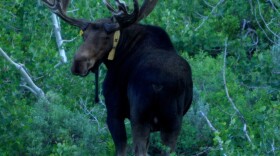Ash Meadows just may be the most magical place in Nevada. So magical, in fact, that it was among the first in the U.S. to be designated a Ramsar site — a wetland with international importance under the purview of UNESCO. The rare oasis is the last of its kind in the Mojave Desert, with the highest concentration of endemic species in the nation. It’s a diverse habitat of dunes, alkali seeps, and groves, as host Connor Fields discovered in this episode of Vegas PBS’s “Outdoor Nevada.” The refuge surrounds a detached unit of Death Valley National Park, known as Devils Hole, home to the only naturally occurring population of the endangered Devils Hole pupfish.
“It is truly special,” Fields said after touring Devils Hole and nearby facility with conservation workers. “They work every single day to keep a species in existence. This lab is fascinating and amazing to see in person, to see science at work.”
It’s also home to other endemic pupfish, flowers, plants, beetles, and snails.
“We have an endemic species of spring snail. It's a pebble snail. It's called Pyrgulopsis crystalis, and it’s only found in a narrow band around the orifice of the spring, and nowhere else, not in any of the other springs, even,” Amber, a member of the U.S. Fish and Wildlife service, says in the episode.
Ash Meadows, northeast of Las Vegas near the California border, is also between two major flyways (migrating bird routes), meaning the springs, reservoirs, and marshes are home to a vast diversity of migratory birds all year round — especially in spring and fall. About 240 species have been seen there, compared to the nearly 500 spotted in total in Nevada.
Point of Rocks and King’s Pool are hotspots for desert birds such as Phainopepla and Greater Roadrunner; the refuge is home to warblers and is a breeding habitat for the Southwest Willow Flycatcher, according to Red Rock Audubon. In winter at the Crystal Reservoir, expect to see a variety of ducks, waterfowl and raptors. Along the park’s boardwalks, while admiring the crystalline pupfish habitats, look into the shrubs for Black and Say’s phoebes, Western Bluebirds, and sparrows.
For those who delight in the desert’s wonders, this is the perfect locale not only to get swept in its beauty, but also to take in the vital ecosystems the refuge provides for countless species. (Based on personal experience, it’s also a lovely place for an engagement proposal!) Conservationists say the Amargosa Valley that surrounds Ash Meadows is at risk from lithium mining, which would put their already endangered species at further risk. For more on that, find our Desert Air podcast and listen to the episode, “River Watch.”
Getting there: From Las Vegas, take U.S. 95 north for about an hour to Amargosa Valley —making sure to stop by the Area 51 Alien Center. Then make a left turn onto NV-373 and follow that road south for about 15 miles. Turn left onto Spring Meadows Road, and take that for 5.4 miles. The last stretch is rough road, but take it slow and you’ll be fine.
Hiking: From the refuge visitors center, you can walk the Crystal Springs interpretive boardwalk that spans less than a mile and features pond overlooks and benches. There are a couple longer hikes in the refuge that are also rich in culture and nature. For maps, visit fws.gov/refuge/ash-meadows.
Pro-tip: There is no entrance fee to the refuge, and it’s open typically from sunrise to sunset. Spring (April and May) and fall (mid-August and September) are the most rewarding for birders, but remember in those later summer months – it’s hot out there!









